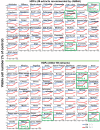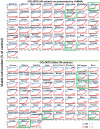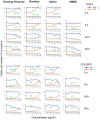Comprehensive Study of Anti-UVC Activity and Cytotoxicity of Hot-water Soluble Herb Extracts
- PMID: 37369486
- PMCID: PMC10347934
- DOI: 10.21873/invivo.13239
Comprehensive Study of Anti-UVC Activity and Cytotoxicity of Hot-water Soluble Herb Extracts
Abstract
Background/aim: COVID-19 pandemic caused the rapid dissemination of ultraviolet C (UVC) sterilization apparatuses. Prolonged exposure to UVC, however, may exert harmful effects on the human body. The aim of the present study was to comprehensively investigate the anti-UVC activity of a total of 108 hot-water soluble herb extracts, using human dermal fibroblast and melanoma cell lines, for the future development of skin care products.
Materials and methods: Exposure time to UVC was set to 3 min, and cell viability was determined using the MTT assay. Anti-UVC activity was determined using the selective index (SI), a ratio of 50% cytotoxic concentration for unirradiated cells to 50% effective concentration that restored half of the UVC-induced decrease of viability.
Results: Dermal fibroblasts at any population doubling level were more resistant to UVC irradiation than melanoma cells. Both 49 herb extracts recommended by Japan Medical Herb Association (JAMHA) and 59 additional herb extracts showed comparable anti-UVC activity. SI values of selected herbs (Butterbur, Cloves, Curry Tree, Evening Primrose, Rooibos, Stevia, Willow) were several-fold lower than those of vitamin C and vanillin. Their potent anti-UVC activity was maintained for at least 6 h post irradiation, but declined thereafter to the basal level, possibly due to cytotoxic ingredients.
Conclusion: UVC sensitivity may be related to the growth potential of target cells. Removal of cytotoxic ingredients of herb extracts may further potentiate and prolong their anti-UVC activity.
Keywords: UVC sensitivity; dermal fibroblast; malignancy; melanoma; protection; water-soluble herb extract.
Copyright © 2023, International Institute of Anticancer Research (Dr. George J. Delinasios), All rights reserved.
Conflict of interest statement
The Authors confirm that there are no known conflicts of interest associated with this publication and there has been no significant financial support for this work that could have influenced its outcome.
Figures







Similar articles
-
UVC-Protective Activity of Lemongrass Among 12 Fat-soluble Herbal Extracts: Rapid Decay Due to Cytotoxicity.In Vivo. 2023 Nov-Dec;37(6):2464-2472. doi: 10.21873/invivo.13353. In Vivo. 2023. PMID: 37905640 Free PMC article.
-
Comparison of UVC Sensitivity and Dectin-2 Expression Between Malignant and Non-malignant Cells.In Vivo. 2022 Sep-Oct;36(5):2116-2125. doi: 10.21873/invivo.12937. In Vivo. 2022. PMID: 36099100 Free PMC article.
-
Prominent Anti-UVC Activity of Lignin Degradation Products.In Vivo. 2022 Nov-Dec;36(6):2689-2699. doi: 10.21873/invivo.13004. In Vivo. 2022. PMID: 36309360 Free PMC article.
-
Recent advances in characterizing biological mechanisms underlying UV-induced wrinkles: a pivotal role of fibrobrast-derived elastase.Arch Dermatol Res. 2008 Apr;300 Suppl 1:S7-20. doi: 10.1007/s00403-007-0798-x. Arch Dermatol Res. 2008. PMID: 17968573 Review.
-
Final report on the safety assessment of capsicum annuum extract, capsicum annuum fruit extract, capsicum annuum resin, capsicum annuum fruit powder, capsicum frutescens fruit, capsicum frutescens fruit extract, capsicum frutescens resin, and capsaicin.Int J Toxicol. 2007;26 Suppl 1:3-106. doi: 10.1080/10915810601163939. Int J Toxicol. 2007. PMID: 17365137 Review.
Cited by
-
Potential Medicinal Efficacy of Alkaline Extract of Pine Seed Shell: Anti-UVC Activity and Macrophage Activation.In Vivo. 2024 Nov-Dec;38(6):2629-2638. doi: 10.21873/invivo.13739. In Vivo. 2024. PMID: 39477410 Free PMC article.
-
UVC-Protective Activity of Lemongrass Among 12 Fat-soluble Herbal Extracts: Rapid Decay Due to Cytotoxicity.In Vivo. 2023 Nov-Dec;37(6):2464-2472. doi: 10.21873/invivo.13353. In Vivo. 2023. PMID: 37905640 Free PMC article.
References
-
- Wölfel R, Corman VM, Guggemos W, Seilmaier M, Zange S, Müller MA, Niemeyer D, Jones TC, Vollmar P, Rothe C, Hoelscher M, Bleicker T, Brünink S, Schneider J, Ehmann R, Zwirglmaier K, Drosten C, Wendtner C. Virological assessment of hospitalized patients with COVID-2019. Nature. 2020;581(7809):465–469. doi: 10.1038/s41586-020-2196-x. - DOI - PubMed
-
- Russo C, Bartolini D, Corbucci C, Stabile AM, Rende M, Gioiello A, Cruciani G, Mencacci A, Galli F, Pietrella D. Effect of a UV-C automatic last-generation mobile robotic system on multi-drug resistant pathogens. Int J Environ Res Public Health. 2021;18(24):13019. doi: 10.3390/ijerph182413019. - DOI - PMC - PubMed
MeSH terms
Substances
LinkOut - more resources
Full Text Sources
Medical
Research Materials
